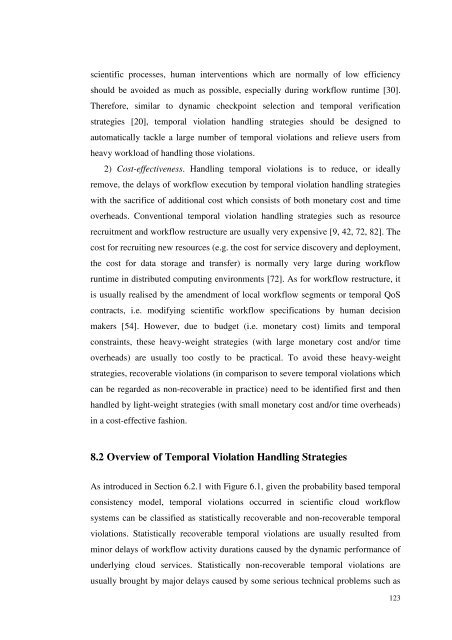Xiao Liu PhD Thesis.pdf - Faculty of Information and Communication ...
Xiao Liu PhD Thesis.pdf - Faculty of Information and Communication ...
Xiao Liu PhD Thesis.pdf - Faculty of Information and Communication ...
You also want an ePaper? Increase the reach of your titles
YUMPU automatically turns print PDFs into web optimized ePapers that Google loves.
scientific processes, human interventions which are normally <strong>of</strong> low efficiency<br />
should be avoided as much as possible, especially during workflow runtime [30].<br />
Therefore, similar to dynamic checkpoint selection <strong>and</strong> temporal verification<br />
strategies [20], temporal violation h<strong>and</strong>ling strategies should be designed to<br />
automatically tackle a large number <strong>of</strong> temporal violations <strong>and</strong> relieve users from<br />
heavy workload <strong>of</strong> h<strong>and</strong>ling those violations.<br />
2) Cost-effectiveness. H<strong>and</strong>ling temporal violations is to reduce, or ideally<br />
remove, the delays <strong>of</strong> workflow execution by temporal violation h<strong>and</strong>ling strategies<br />
with the sacrifice <strong>of</strong> additional cost which consists <strong>of</strong> both monetary cost <strong>and</strong> time<br />
overheads. Conventional temporal violation h<strong>and</strong>ling strategies such as resource<br />
recruitment <strong>and</strong> workflow restructure are usually very expensive [9, 42, 72, 82]. The<br />
cost for recruiting new resources (e.g. the cost for service discovery <strong>and</strong> deployment,<br />
the cost for data storage <strong>and</strong> transfer) is normally very large during workflow<br />
runtime in distributed computing environments [72]. As for workflow restructure, it<br />
is usually realised by the amendment <strong>of</strong> local workflow segments or temporal QoS<br />
contracts, i.e. modifying scientific workflow specifications by human decision<br />
makers [54]. However, due to budget (i.e. monetary cost) limits <strong>and</strong> temporal<br />
constraints, these heavy-weight strategies (with large monetary cost <strong>and</strong>/or time<br />
overheads) are usually too costly to be practical. To avoid these heavy-weight<br />
strategies, recoverable violations (in comparison to severe temporal violations which<br />
can be regarded as non-recoverable in practice) need to be identified first <strong>and</strong> then<br />
h<strong>and</strong>led by light-weight strategies (with small monetary cost <strong>and</strong>/or time overheads)<br />
in a cost-effective fashion.<br />
8.2 Overview <strong>of</strong> Temporal Violation H<strong>and</strong>ling Strategies<br />
As introduced in Section 6.2.1 with Figure 6.1, given the probability based temporal<br />
consistency model, temporal violations occurred in scientific cloud workflow<br />
systems can be classified as statistically recoverable <strong>and</strong> non-recoverable temporal<br />
violations. Statistically recoverable temporal violations are usually resulted from<br />
minor delays <strong>of</strong> workflow activity durations caused by the dynamic performance <strong>of</strong><br />
underlying cloud services. Statistically non-recoverable temporal violations are<br />
usually brought by major delays caused by some serious technical problems such as<br />
123
















